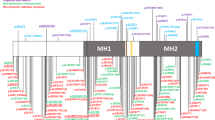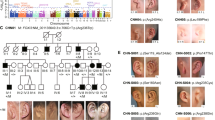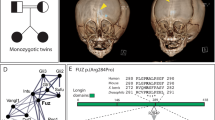Abstract
Apert syndrome is a distinctive human malformation comprising craniosynostosis and severe syndactyly of the hands and feet. We have identified specific missense substitutions involving adjacent amino acids (Ser252Trp and Pro253Arg) in the linker between the second and third extracellular immunoglobulin (Ig) domains of fibroblast growth factor receptor 2 (FGFR2) in all 40 unrelated cases of Apert syndrome studied. Crouzon syndrome, characterized by craniosynostosis but normal limbs, was previously shown to result from allelic mutations of the third Ig domain of FGFR2. The contrasting effects of these mutations provide a genetic resource for dissecting the complex effects of signal transduction through FGFRs in cranial and limb morphogenesis.
This is a preview of subscription content, access via your institution
Access options
Subscribe to this journal
Receive 12 print issues and online access
$209.00 per year
only $17.42 per issue
Buy this article
- Purchase on Springer Link
- Instant access to full article PDF
Prices may be subject to local taxes which are calculated during checkout
Similar content being viewed by others
References
Apert, M.E.,De I'acrocephaiosyndactylie. Bull. Soc. Med. Hôp. Paris 23, 1310–1313 (1906).
Cohen, M.M. Jr., et al. Birth prevalence study of the Apert syndrome. Am. J. med. Genet. 42, 655–659 (1992).
Blank, C.E. Apert's syndrome (a type of acrocephalosyndactyly)-observations on a British series of thirty-nine cases. Ann. hum. Genet. 24, 151–164 (1960).
Cohen, M.M. Jr, & Kreiborg, S. The central nervous system in the Apert syndrome. Am. J. med. Genet. 36, 36–45 (1990).
Upton, J. & Zuker, R.M. eds. Apert syndrome. Clin. Plast. Surg. 18, 1–435 (W.B. Saunders, Philadelphia, 1991).
Cohen, M.M. Jr., Kreiborg, S. Visceral anomalies in the Apert syndrome. Am. J. med. Genet. 45, 758–760 (1993).
Cohen, M.M Jr. & Kreiborg, S. Skeletal abnormalities in the Apert syndrome. Am. J. med. Genet. 47, 624–632 (1993).
Patton, M.A., Goodship, J., Hayward, R. & Lansdown, R. Intellectual development jn Apert's syndrome: a long term follow up of 29 patients. J. med. Genet. 25, 164–167 (1988).
Campis, L.B. Children with Apert syndrome: developmental and psychologic considerations. Clin. Plast. Surg. 18, 409–416 (1991).
Lewanda, A.F. et al. Cytogenetic survey of Apert syndrome. Reevaluation of a translocation (2;9)(p11,2;q34.2) in a patient suggests the breakpoints are not related to the disorder. Am. J. Dis. Child. 147, 1306–1308 (1993).
Jabs, E.W. et al. A mutation in the homeodomaln of the human MSX2 gene in a family affected with autosomal dominant craniosynostosis. Cell 75, 443–450 (1993).
Reardon, W. et al. Mutations In the fibroblast growth factor receptor 2 gene cause Crouzon syndrome. Nature Genet. 8, 98–103 (1994).
Jabs, E.W. et al. Jackson-Weiss and Crouron syndromes are allelic with mutations in fibroblast growth factor receptor 2. Nature Genet. 8, 275–279 (1994).
Muenke, M. et al. Mutations in the fibroblast growth factor receptor-1 gene in Pfeiffer syndrome. Nature Genet. 8, 269–274 (1994).
Johnson, R.L., Riddle, R.D. & Tabin, C.J. Mechanisms of limb patterning. Curr. Opin. Genet. Dev. 4, 535–542 (1994).
Davidson, D.R., Crawley, A., Hill, R.E. & Tickle, C. Position-dependent expression of two related homeobox genes in developing vertebrate limbs. Nature 352, 429–431 (1991).
Robert, B., Lyons, G., Simandl, B.K., Kuroiwa, A. & Buckingham, M. The apical ectodermal ridge regulates Hox-7 and Hox-8 gene expression in developing chick limb buds. Genes Dev. 5, 2363–2374 (1991).
Anderson, R., Landry, M. & Muneoka, K. Maintenance of ZPA signaling in cultured mouse limb bud cells. Development 117, 1421–1433 (1993).
Niswander, L., Tickle, C., Vogel, A., Booth, I. & Martin, G.R. FGF-4 replaces the apical ectodermal ridge and directs outgrowth and patterning of the limb. Cell 75, 579–587 (1993).
Niswander, L., Jeffrey, S., Martin, G.R. & Tickle, C. A positive feedback loop coordinates growth and patterning in the vertebrate limb. Nature 371, 609–612 (1994).
Fallon, J.F. et al. FGF-2: apical ectodermal ridge growth signal for chick limb development. Science 264, 104–107 (1994).
Orr-Urtreger, A., Givol, D., Yayon, A., Yarden, Y. & Lonai, P. Developmental expression of two murine fibroblast growth factor receptors, flg and bek. Development 113, 1419–1434 (1991).
Peters, K.G., Werner, S., Chen, G. & Williams, L.T. Two FGF receptor genes are differentially expressed in epithelial and mesenchymal tissues during limb formation and organogenesis in the mouse. Development 114, 233–243 (1992).
Peters, K., Ornitz, D., Werner, S. & Williams, L. Unique expression pattern of the FGF receptor 3 gene during mouse organogenesis. Dev. Biol. 155, 423–430 (1993).
Shiang, R. et al. Mutations in the transmembrane domain of FGFR3 cause the most common genetic form of dwarfism, achondroplasia. Cell 78, 335–342 (1994).
Rousseau, F. et al. Mutations in the gene encoding fibroblast growth factor receptor-3 in achondroplasia. Nature 371, 252–254 (1994).
Francomano, C.A. et al. Localization of the achondroplasia gene to the distal 2.5 Mb of human chromosome 4p. Hum. molec. Genet. 3, 787–792 (1994).
Velinov, M. et al. The gene for achondroplasia maps to the telomeric region of chromosome 4p. Nature Genet. 6, 314–317 (1994).
Mattei, M.-G., Moreau, A., Gesnel, M.-C., Houssaint, E. & Breathnach, R. Assignment by in situ hybridization of a fibroblast growth factor receptor gene to human chromosome band 10q26. Hum. Genet. 87, 84–86 (1991).
Dionne, C.A. et al. BEK, a receptor for multiple members of the fibroblast growth factor (FGF) family, maps to human chromosome 10q25.3→q26. Cytogenet. Cell Genet. 60, 34–36 (1992).
Preston, R.A. et al. A gene for Crouzon craniofacial dysostosis maps to the long arm of chromosome 10. Nature Genet. 7, 149–153 (1994).
Li, X. et al. Two craniosynostotic syndrome loci, Crouzon and Jackson-Weiss, map to chromosome 10q23-q26. Genomics 22, 418–424 (1994).
Johnson, D.E., Lu, J., Chen, H., Werner, S. & Williams, L.T. The human fibroblast growth factor receptor genes: a common structural arrangement underlies the mechanisms for generating receptor forms that differ in their third Immunoglobulin domain. Molec. cell. Biol. 11, 4627–4634 (1991).
Yayon, A. et al. A confined variable region confers ligand specificity on fibroblast growth factor receptors: implications for the origin of the immunoglobulin fold. EMBO J. 11, 1885–1890 (1992).
Dionne, C.A. et al. Cloning and expression of two distinct high-affinity receptors cross-reacting with acidic and basic fibroblast growth factors. EMBO J. 9, 2685–2692 (1990).
Givol, D. & Yayon, A. Complexity of FGF receptors: genetic basis for structural diversity and functional specificity. FASEB J. 6, 3362–3369 (1992).
Miki, T. et al. Determination of ligand-binding specificity by alternative splicing: Two distinct growth factor receptors encoded by a single gene. Proc. natn. Acad. Sci. U.S.A. 89, 246–250 (1992).
Houssaint, E. et al. Related fibroblast growth factor receptor genes exist in the human genome. Proc. natn. Acad. Sci. U.S.A. 87, 8180–8184 (1990).
Erickson, J.D. & Cohen, M.M. Jr., A study of parental age effects on the occurrence of fresh mutations for the Apert syndrome.Ann. num. Genet. 38, 89–96 (1974).
Upton, J. Apert syndrome. Classification and pathologic anatomy of limb anomalies. Clin. Plast. Surg. 18, 321–355 (1991).
Cooper, D.N. & Krawczak, M. The mutational spectrum of single base-pair substitutions causing human genetic disease: patterns and predictions. Hum. Genet. 85, 55–74 (1990).
Ketterling, R.P., Vielhaber, E. & Sommer, S.S. The rates of G:C→T:A and G:C→C:G transversions at CpG dinucleotldes in the human factor IX gene. Am. J. hum. Genet. 54, 831–835 (1994).
Mason, I.J. The ins and outs of fibroblast growth factors. Cell 78, 547–552 (1994).
Johnson, D.E. & Williams, L.T. Structural and functional diversity in the FGF receptor multigene family. Adv. Cancer Res. 60, 1–41 (1993).
Orr-Urtreger, A. et al. Developmental localization of the splicing alternatives of fibroblast growth factor receptor-2 (FGFR2). Dev. Biol. 158, 475–486 (1993).
Werner, S. et al. Targeted expression of a dominant-negative FGF receptor mutant in the epidermis of transgenic mice reveals a role of FGF in keratinocyte organization and differentiation. EMBO J. 12, 2635–2643 (1993).
Hou, J. et al. Substitution of putative half-cystine residues in heparin-bindlng fibroblast growth factor receptors. Loss of binding activity in both two and three loop isoforms. J. biol. Chem. 267, 17804–17808 (1992).
Zimmer, Y., Givol, D. & Yayon, A. Multiple structural elements determine ligand binding of fibroblast growth factor receptors. Evidence that both Ig domain 2 and 3 define receptor specificity. J. biol. Chem. 268, 7899–7903 (1993).
Williams, A.F. & Barclay, A.N. The immunoglobulin superfamily -domains for cell surface recognition. A. Rev. Immunol. 6, 381–405 (1988).
Xu, J. et al. Expression and immunochemical analysis of rat and human fibroblast growth factor receptor (fig) isoforms. J. biol. Chem. 267, 17792–17803 (1992).
Pantoliano, M.W. et al. Multivalent ligand-receptor binding interactions in the fibroblast growth factor system produce a cooperative growth factor and heparin mechanism for receptor dimerization. Biochemistry 33, 10229–10248 (1994).
Jones, E.Y., Davis, S.J., Williams, A.F., Harlos, K. & Stuart, D.I. Crystal structure at 2. 8 Å resolution of a soluble form of the cell adhesion molecule CD2. Nature 360, 232–239 (1992).
Avraham, K.B. et al. Mapping of murine fibroblast growth factor receptors refines regions of homology between mouse and human chromosomes. Genomics 21, 656–658 (1994).
Grüneberg, H. Genetical studies on the skeleton of the mouse. XVIII. Three genes for syndactylism. J. Genet. 54, 113–145 (1956).
Grüneberg, H. Genetical studies on the skeleton of the mouse. XXV. The development of syndactylism. Genet. Res. 1, 196–213 (1960).
Grüneberg, H. Genetical studies on the skeleton of the mouse. XXVII. The development of Oligosyndactylism. Genet. Res. 2, 33–42 (1961).
Grüneberg, H. Genetical studies on the skeleton of the mouse. XXXII. The development of shaker with syndactylism. Genet. Res. 3, 157–166 (1962).
Jarvik, G.P., Patton, M.A., Homfray, T. & Evans, J.P. Non-Mendelian transmission in a human developmental disorder: split hand/split foot. Am. J. hum. Genet. 55, 710–713 (1994).
Hofstra, R.M.W. et al. A mutation in the RET proto-oncogene associated with multiple endocrine neoplasia type 2B and sporadic medullary thyroid carcinoma. Nature 367, 375–376 (1994).
Carlson, K.M. et al. Single missense mutation in the tyrosine kinase catalytic domain of the RET protooncogene is associated with multiple endocrine neoplasia type 2B. Proc. natn. Acad. Sci. U.S.A. 91, 1579–1583 (1994).
Sambrook, J., Fritsch, E.F. & Maniatis, T. Molecular cloning: a laboratory manual, 2nd edn. (Cold Spring Harbor Laboratory Press, 1989).
Hazan, J., Dubay, C., Pankowiak, M.-P., Becuwe, N. & Weissenbach, J. A genetic linkage map of human chromosome 20 composed entirely of microsatellite markers. Genomics 12, 183–189 (1992).
Padanilam, B.J. et al. Characterization of the human HOX 7 cDNA and Identification of polymorphic markers. Hum. molec. Genet. 1, 407–410 (1992).
Yu, C.-E., Anderson, L., Oshima, J. & Schellenberg, G.D. Dinucleotide repeat polymorphism at the FGFR1 gene. Hum. molec. Genet. 3, 212 (1994).
Taylor, S.A.M., Barnes, G.T., MacDonald, M.E. & Gusella, J.F. A dinucleotide repeat polymorphism at the D4S127 locus.Hum. molec. Genet. 1, 142 (1992).
Weissenbach, J. et al. A second-generation linkage map of the human genome. Nature 359, 794–801 (1992).
MacDonald, M.E. et al. Clustering of multiallele DNA markers near the Huntington's disease gene. J. clin. Invest. 84, 1013–1016 (1989).
Chomczynski, P. & Sacchi, N. Single-step method of RNA isolation by acid guanidinium thiocyanate-phenol-chloroform extraction. Anal. Biochem. 162, 156–159 (1987).
Spinardi, L., Mazars, R. & Theillet, C. Protocols for an improved detection of point mutations by SSCP. Nucl. Acids Res. 19, 4009 (1991).
Glavac, D. & Dean, M. Optimization of the single-strand conformation polymorphism (SSCP) technique for detection of point mutations. Hum. Mut. 2, 404–414 (1993).
Thein, S.L. & Hinton, J. A simple and rapid method of direct sequencing using Dynabeads.Br. J. Haematol. 79, 113–115 (1991).
Rutland, P. et al. Identical mutations in the FGFR2 gene cause both Pfeiffer and Crouzon syndrome phenotypes. Nature Genet 9, 173–176 (1995).
Author information
Authors and Affiliations
Rights and permissions
About this article
Cite this article
Wilkie, A., Slaney, S., Oldridge, M. et al. Apert syndrome results from localized mutations of FGFR2 and is allelic with Crouzon syndrome. Nat Genet 9, 165–172 (1995). https://doi.org/10.1038/ng0295-165
Received:
Accepted:
Issue Date:
DOI: https://doi.org/10.1038/ng0295-165
This article is cited by
-
Acro-osteolysis: imaging, differential diagnosis, and disposition review
Skeletal Radiology (2023)
-
The spontaneous mouse mutant low set ears (Lse) is caused by tandem duplication of Fgf3 and Fgf4
Mammalian Genome (2023)
-
Differential diagnosis of syndromic craniosynostosis: a case series
Archives of Gynecology and Obstetrics (2022)
-
Processing of numerical representation of fingers depends on their location in space
Psychological Research (2021)



